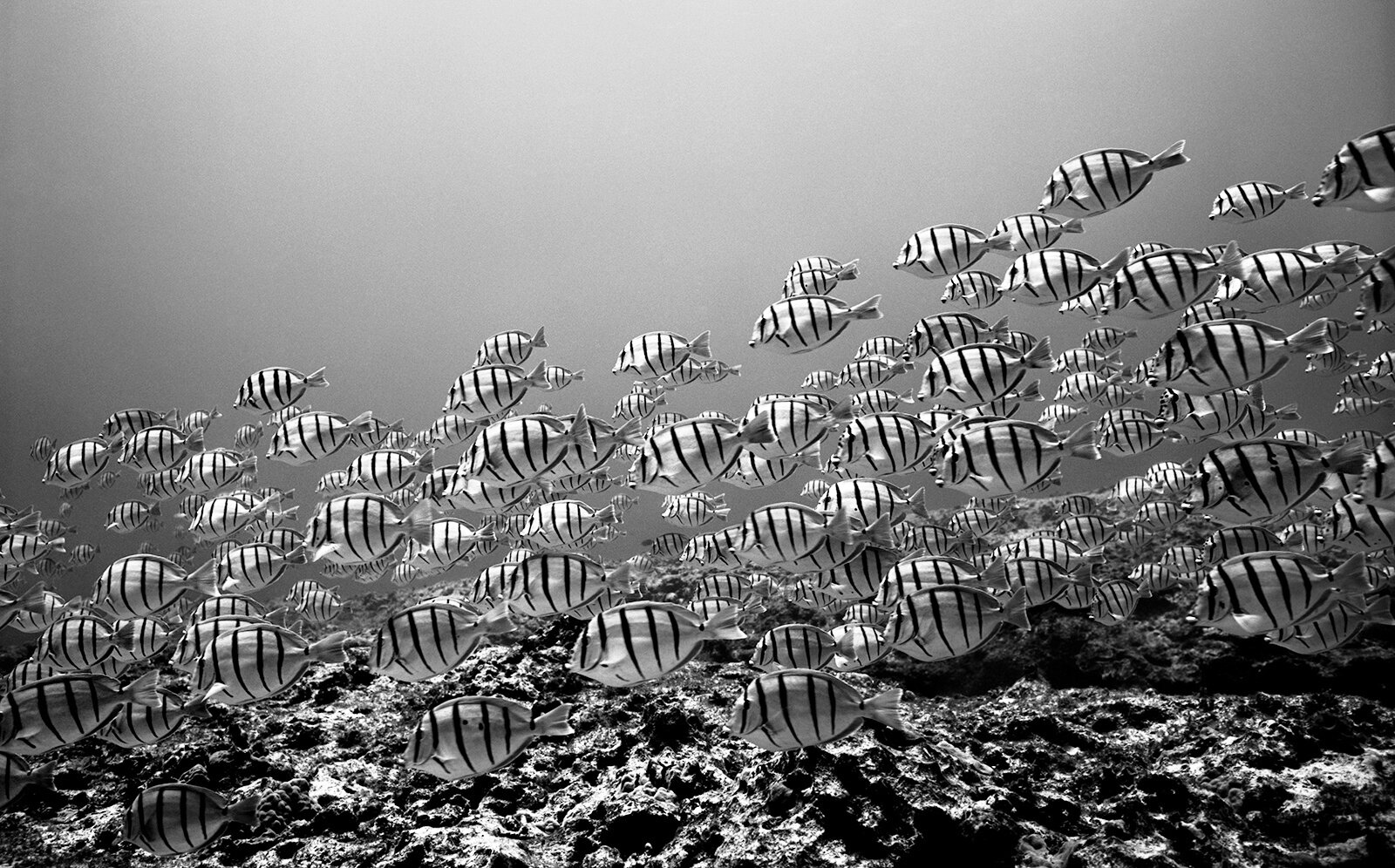
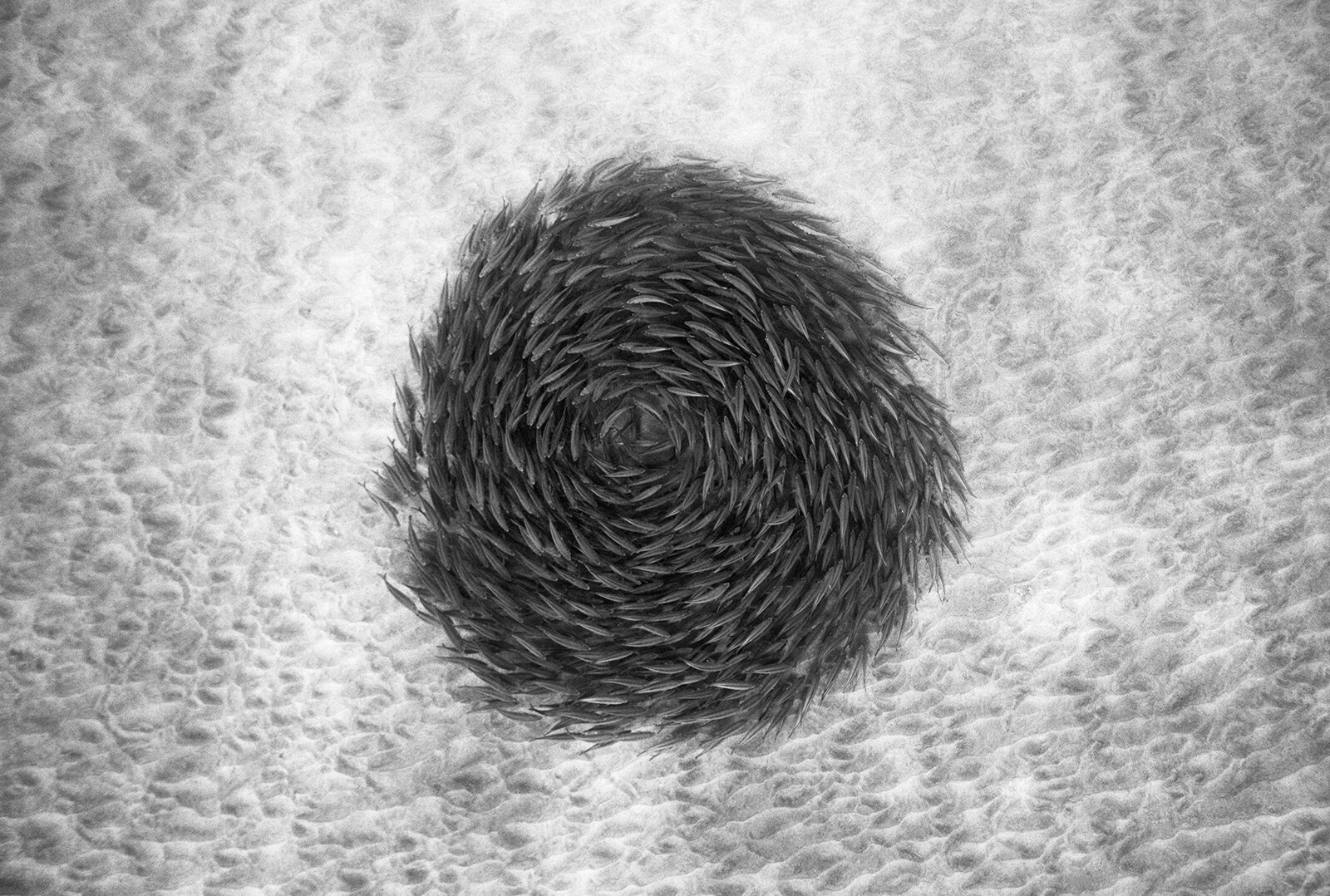
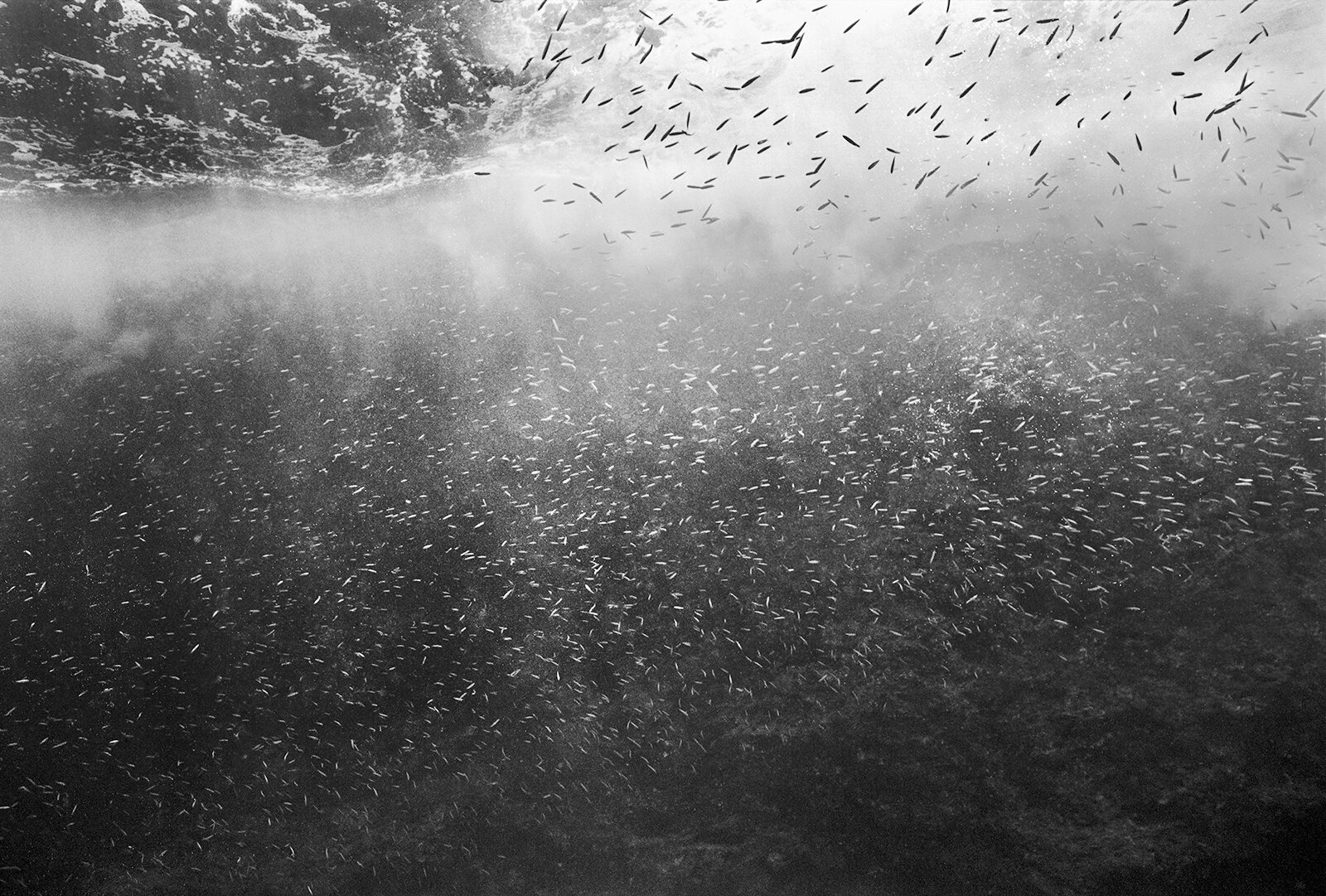
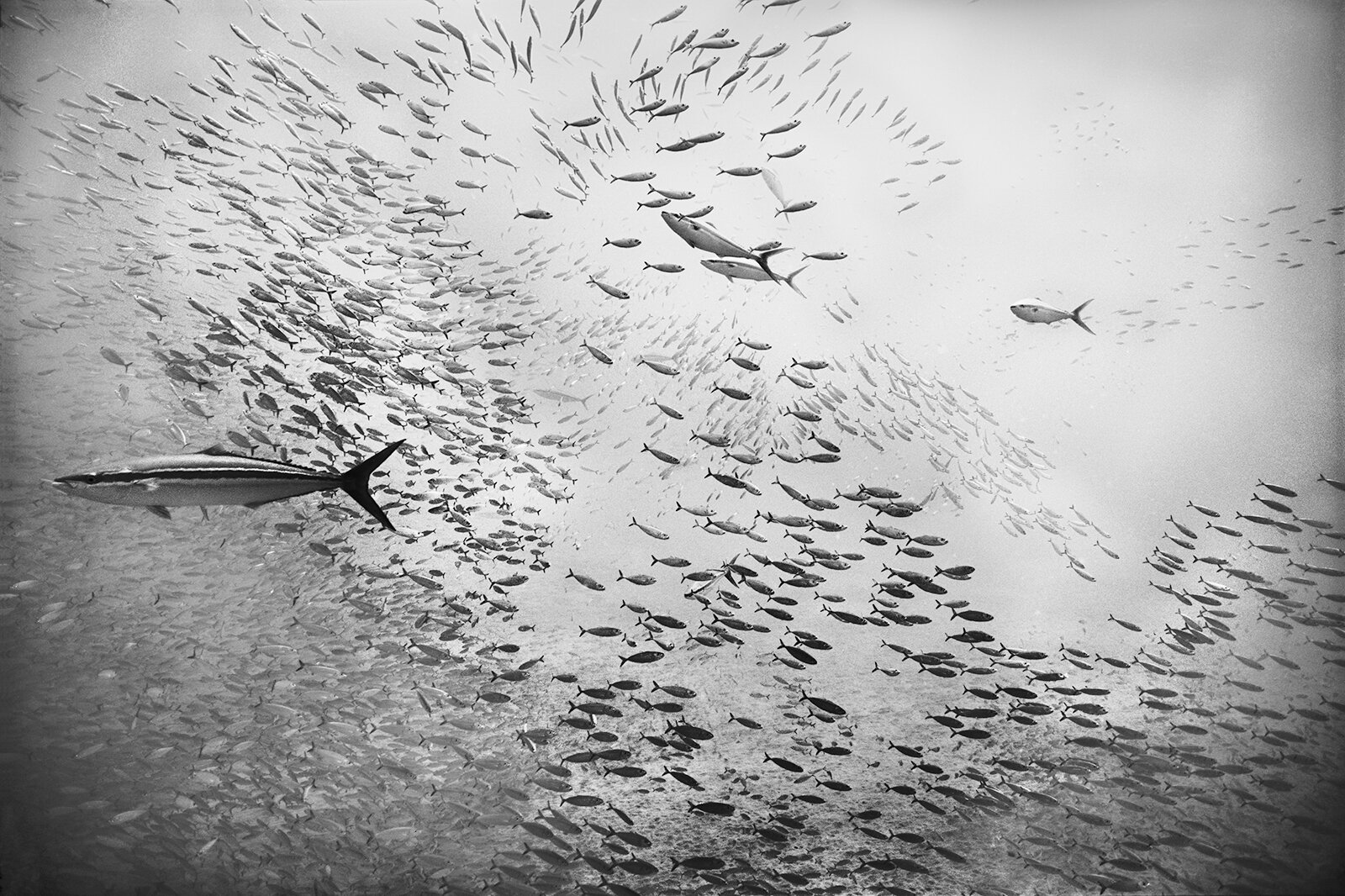
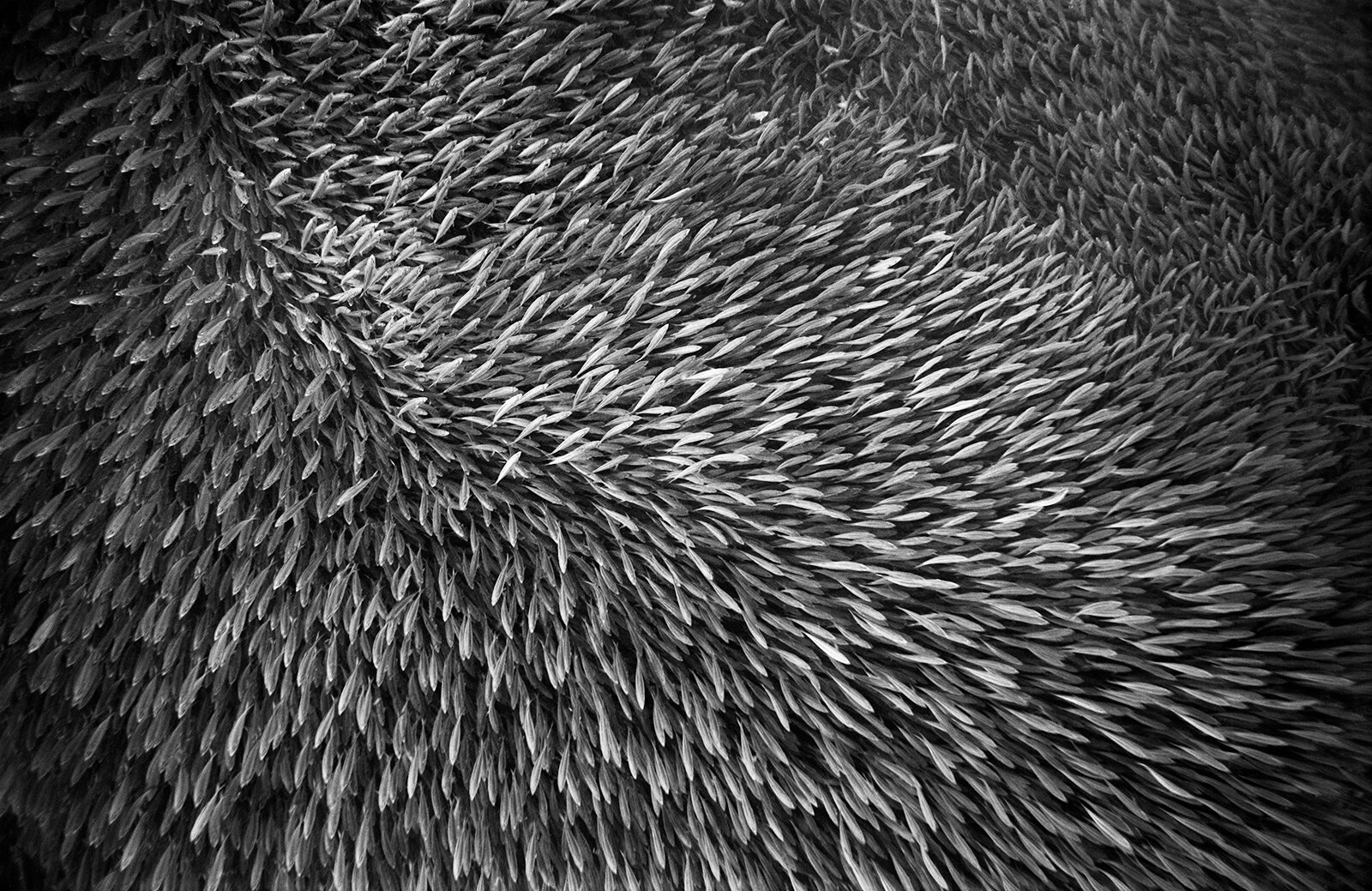
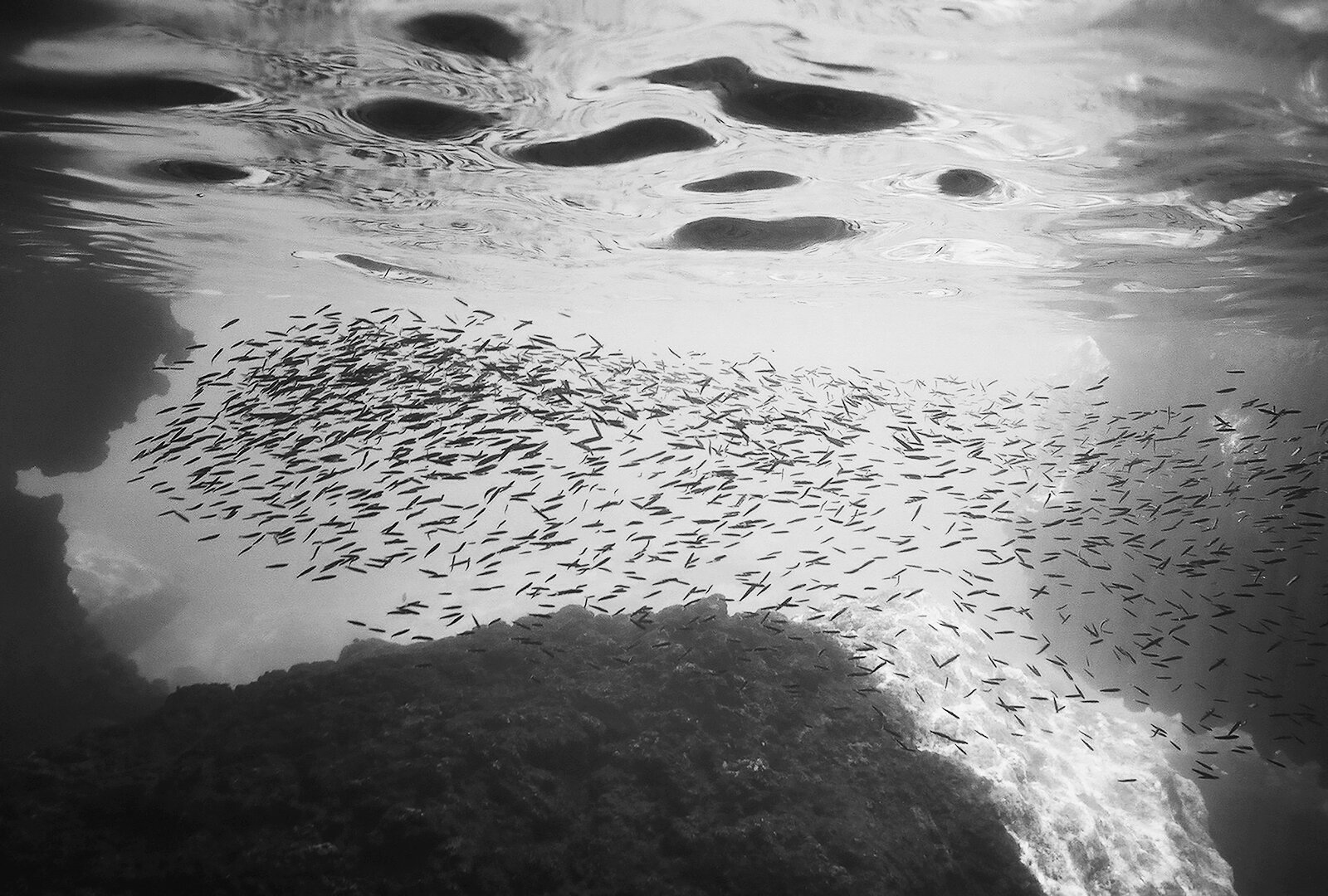
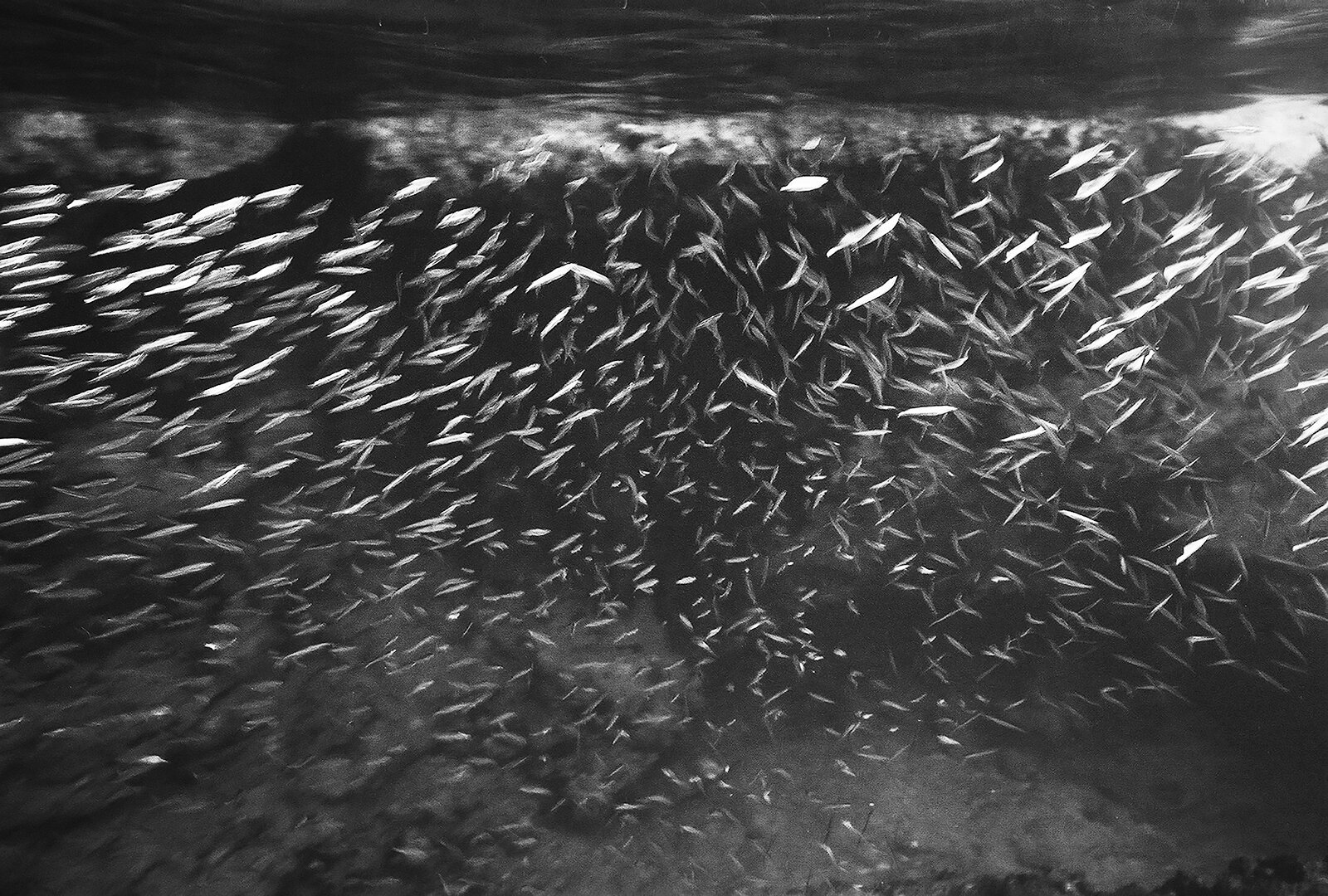
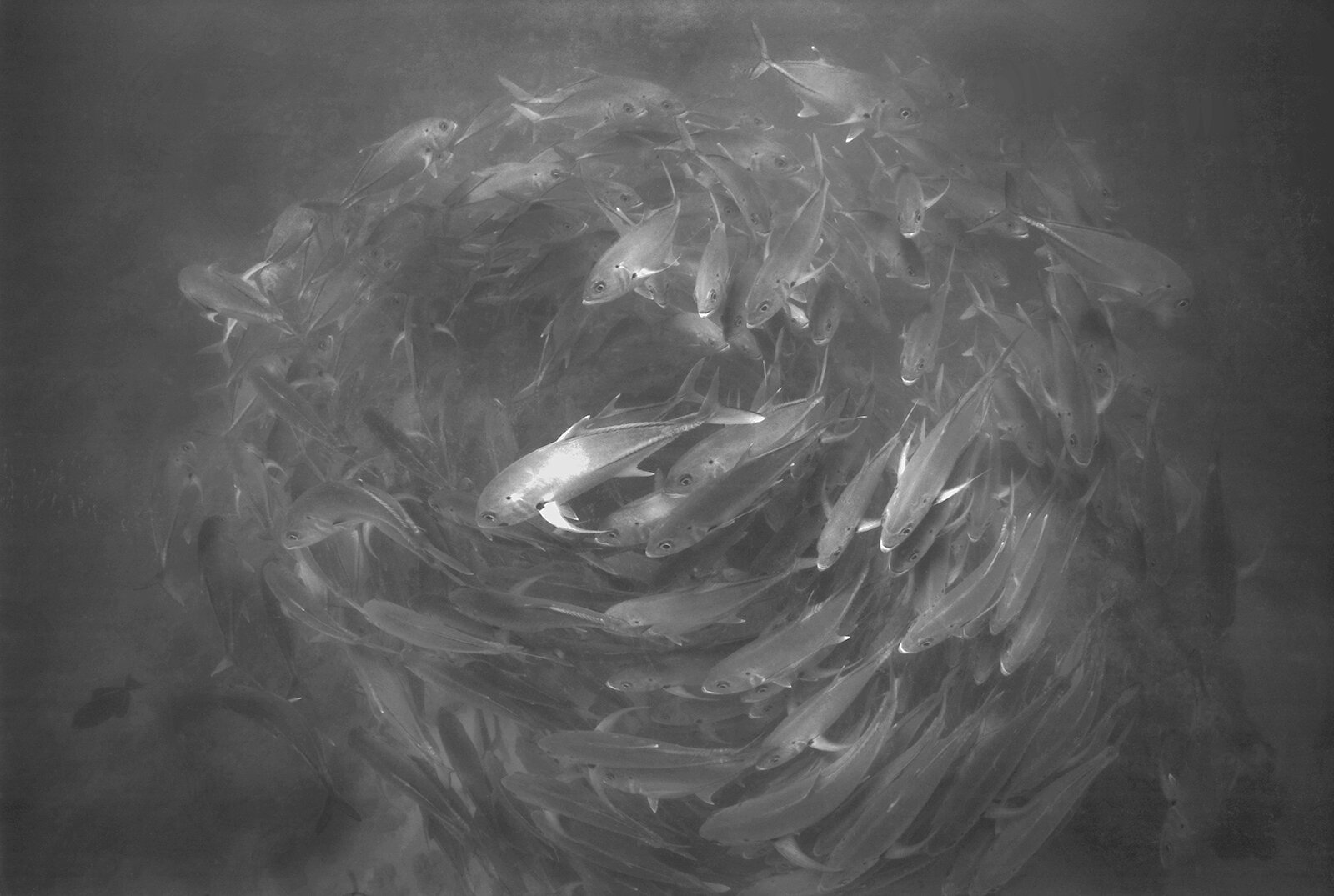
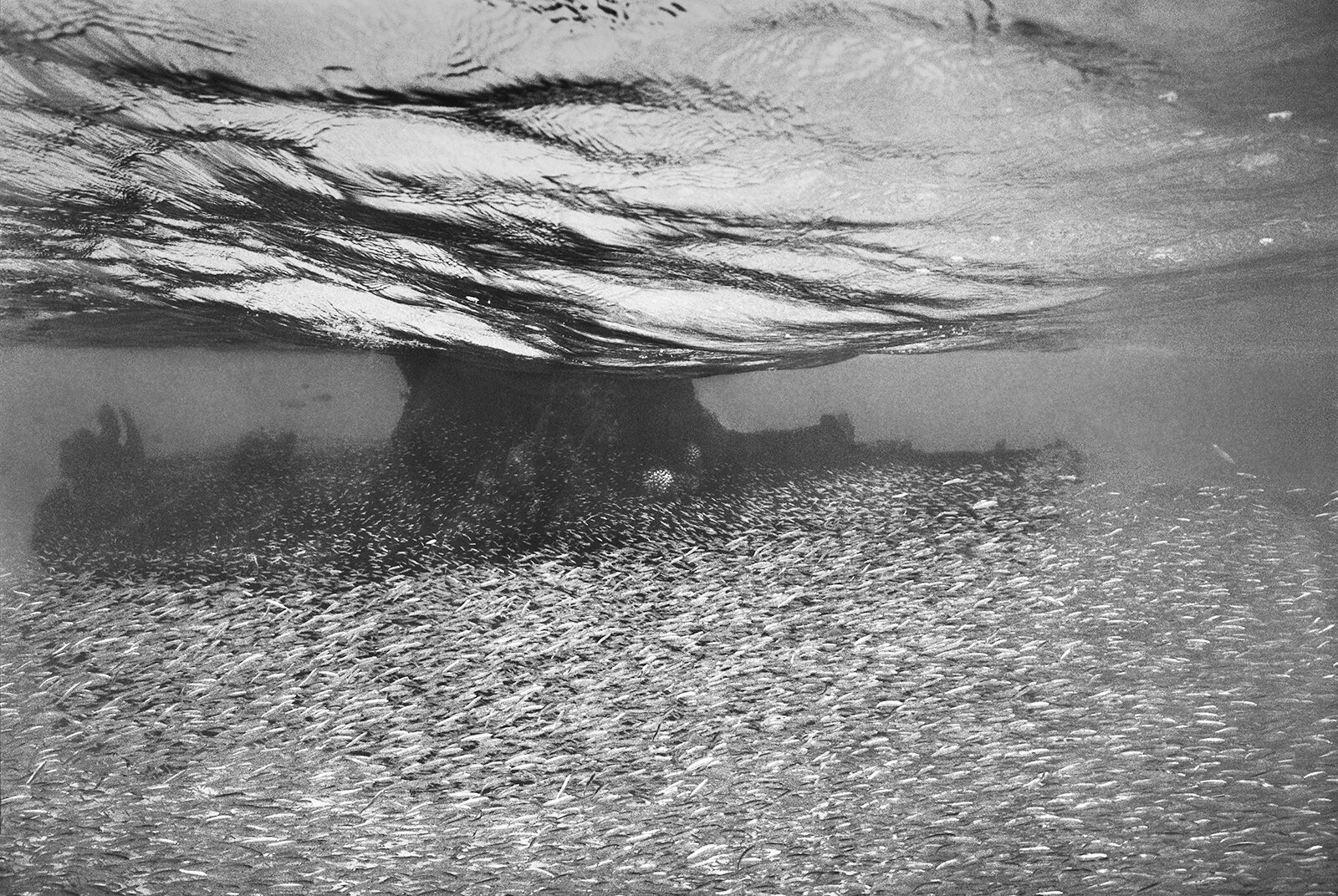
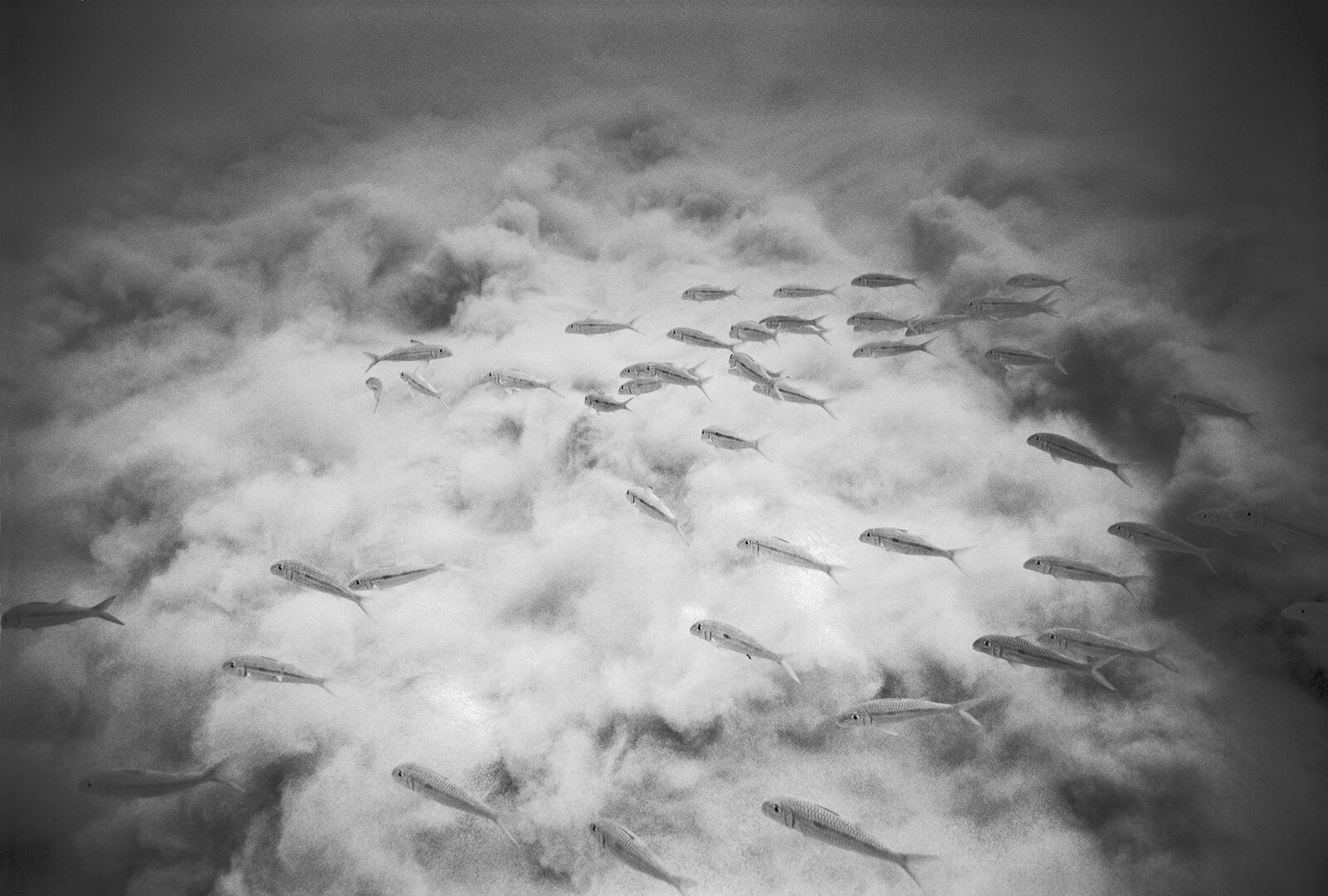
All photos © Wayne Levin
The Question of Akule
I'm swimming out into the bay, searching for the mass of fish that I spotted with my Polaroid glasses from the cliff above. Finally I see what first appears like a dark shadow in the water ahead of me. As I approach the form becomes an amazing shape, and I can make out thousands of individual fish.
When I'm about twenty feet from the school, taking several deep breaths, I dive down. Carefully, slowly, facing away from the school so as not to startle it. At a depth of perhaps forty feet I slowly turn toward the school. When I turn the school explodes, not swimming away but toward me. Thousands of fish, some passing inches from my face, but they never touch me. My reaction...total disorientation, not sure which way is up. Finally I surface to get a much-needed breath of air.
The foregoing was an event that I experienced dozens of times during my photographic exploration of Akule (Big Eyed Scad). Is this behavior, to swim toward and not away from a perceived predator, a survival technique, to confuse rather than flee?
Having observed, and photographed Akule over the past twenty years, I'm amazed by their syncretic behavior. The shapes they make, the coordination of their movements and reactions are difficult to comprehend. How can tens of thousands of individual fish have such amazing coordination? They act more like one large entity, than thousands of separate individuals.
So, what is the individual? Is each Akule a world unto itself, or is the individual the school, with the single fish acting more like cells within a larger being? And what about other forms of life, including humans. Are we really as separate as the structure of our present society leads us to believe, or are we a very small part of a larger entity...humanity...a part of the living earth...a part of the universe.
As an artist I have lived most of my life way out on the individualist limb, barely connected to the tree. But now, at my advancing age, I realize the importance of the branches, the connections. I now believe that only in realizing, and acting on our connections with each other, and our connections to the earth will we survive.
Many of us refuse to wear masks or take vaccines to protect ourselves and others from a pandemic, because we believe it infringes on our individual freedom. What is the meaning of individual freedom when we are looking down the barrel of extinction? But if we as a society are unwilling to take simple steps to fight a pandemic, how are we ever going to deal with even more ominous threats, like climate change, and overpopulation? Perhaps it is now time for our species to transcend what we have been. I never believed that art could effect the future of human civilization, now I think it is one of our last/best hopes.
The Akule have led me to dozens of other kinds of schooling fish. Each type of fish schools differently. Opelu seem almost like anarchist fish, with no apparent uniformity, but they still somehow maintain a connection. Aholehole sometimes form a silver wall of fish with hundreds of black spots (their eyes). Pake Ulua will form swirling funnels. Recently I have become enthralled with tiny schooling fish, Nehu, Iao, and Piha. I even went to England to photograph Starling flocks, and Oregon to photograph migrating Geese. I plan to photograph a huge Aspen grove in Utah that is a huge single organism and an even larger mushroom grove in Oregon, also a single entity. Lastly, I've thought about photographing masses of humans, and their physical spacing, but the pandemic has put a hold on that for now.
So I may spend a large portion of my remaining time pursuing the question posed by the Akule. What is the individual? But I know that I will never find the answer.
- Wayne Levin, October 2021
About Wayne Levin:
Los Angeles native Wayne Levin has been photographing his adopted home of Hawaii for nearly four decades and is known internationally for his striking underwater photographs of swimmers and marine life. He began photographing at age 12 with a Brownie camera given to him by his father. After graduating high school in 1962, he attended Brooks Institute of Photography in Santa Barbara, California but left to participate in the Civil Rights movement in 1964. Over the next several years he worked with the Congress of Racial Equality and the Mississippi Freedom Democratic Party.
Wayne began his underwater photography in 1983 with the purchase of a Nikonos IV underwater camera. To this day he continues to work with black and white photography underwater, often free-diving without the use of a scuba tank. Throughout his photographic career he has also worked on documentary projects addressing the history of the Hawaiian Islands and humanity’s fraught relationship to oceans and ocean life.
Wayne earned a BFA in photography at the San Francisco Art Institute in 1979 (where he studied under Linda Connor, John Collier, Henry Wessel, Larry Sultan, and Ellen Brooks) and an MFA from Pratt Institute in 1982 (where he studied with Arthur Freed and Phil Perkis).
Wayne’s photographs have been exhibited nationally and internationally and can be found in the collections of the Museum of Modern Art, New York; Museum of Photographic Art, San Diego; The Contemporary Museum, Honolulu; and the Hawaii State Foundation on Culture and the Arts.










All photos © Wayne Levin
Selma-Montgomery, and Border
I see a connection between my most recent project and my earliest.
I recently happened upon some slides that I took over 55 years ago at the age of 19. I was then active in the civil rights movement, in the Los Angeles branch of the Congress of Racial Equality (CORE). A group of us from the LA CORE participated in the final day of the 1965 Selma-Montgomery march. I knew I had some pictures but I never thought they were very good. But as I looked through these newly found images (27) I realized that, though they were far from technically perfect, they were unlike most images taken from the front of the march because these were taken in the midst of it. The slides have quite a bit of mildew now, not having been stored in archival conditions, however I actually like the feeling it gives to the images: a feeling of time past.
I have had misgivings about my country’s recent immigration policies and when Trump came into power these policies went from bad to horrible, completely inhumane. I joined a local Resist Trump group, which mainly focused on the immigration issue. I became aware of the artwork being made on the wall and by the children in the internment camps. I looked online for photos of the artwork on the Mexico side of the wall and I became obsessed with the idea of going to Mexico to photograph the wall with its artwork. I watched a 2014 documentary, Hecho en Mexico, and at one point it showed the border wall extending into the ocean. I was amazed, not only were we dividing the land, but we were also dividing the sea.
I wanted these photographs to connect on some level with my ocean work. I decided to photograph the place where the natural border between the Pacific Ocean and the American Continent crosses the man-made border between the US and Mexico.
-Wayne Levin, 2021
About Wayne Levin’s Publications:
Levin has published 10 books of his work and his work has been included in Aperture, American Photographer, Camera Arts, Day in the Life of Hawaii, Photo Japan, and LensWork, among others.
For more information about Levin's books, please visit:
https://www.waynelevinimages.com/books
Wayne Levin, FLOWING, 2014/2019.
Published by Datz Press.
PhotoAlliance Collector Print Program:
PhotoAlliance has two remaining Wayne Levin prints available through our Collector Print Program.
20% discount for October 2021 only.
(Click the images for print details)




